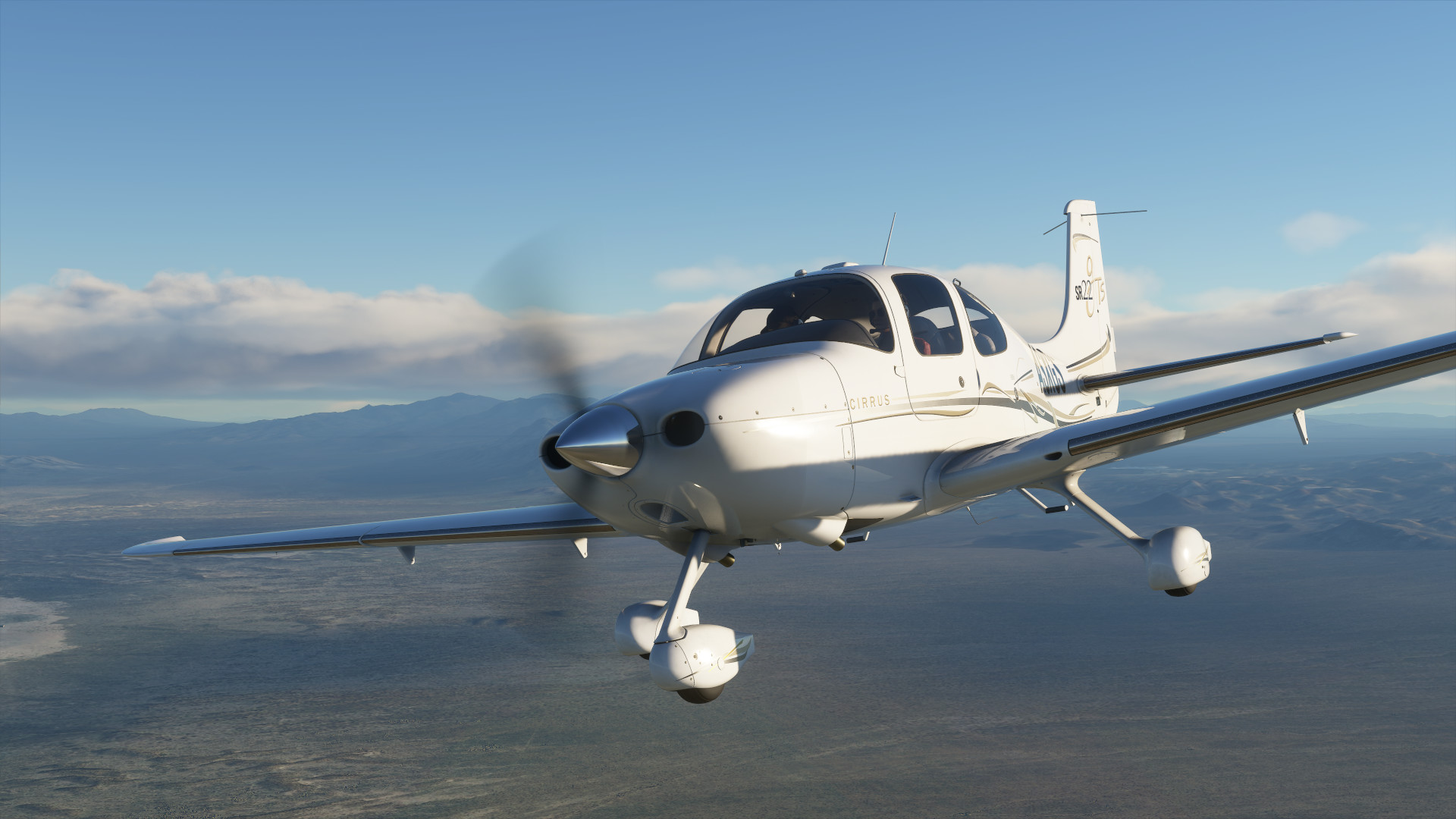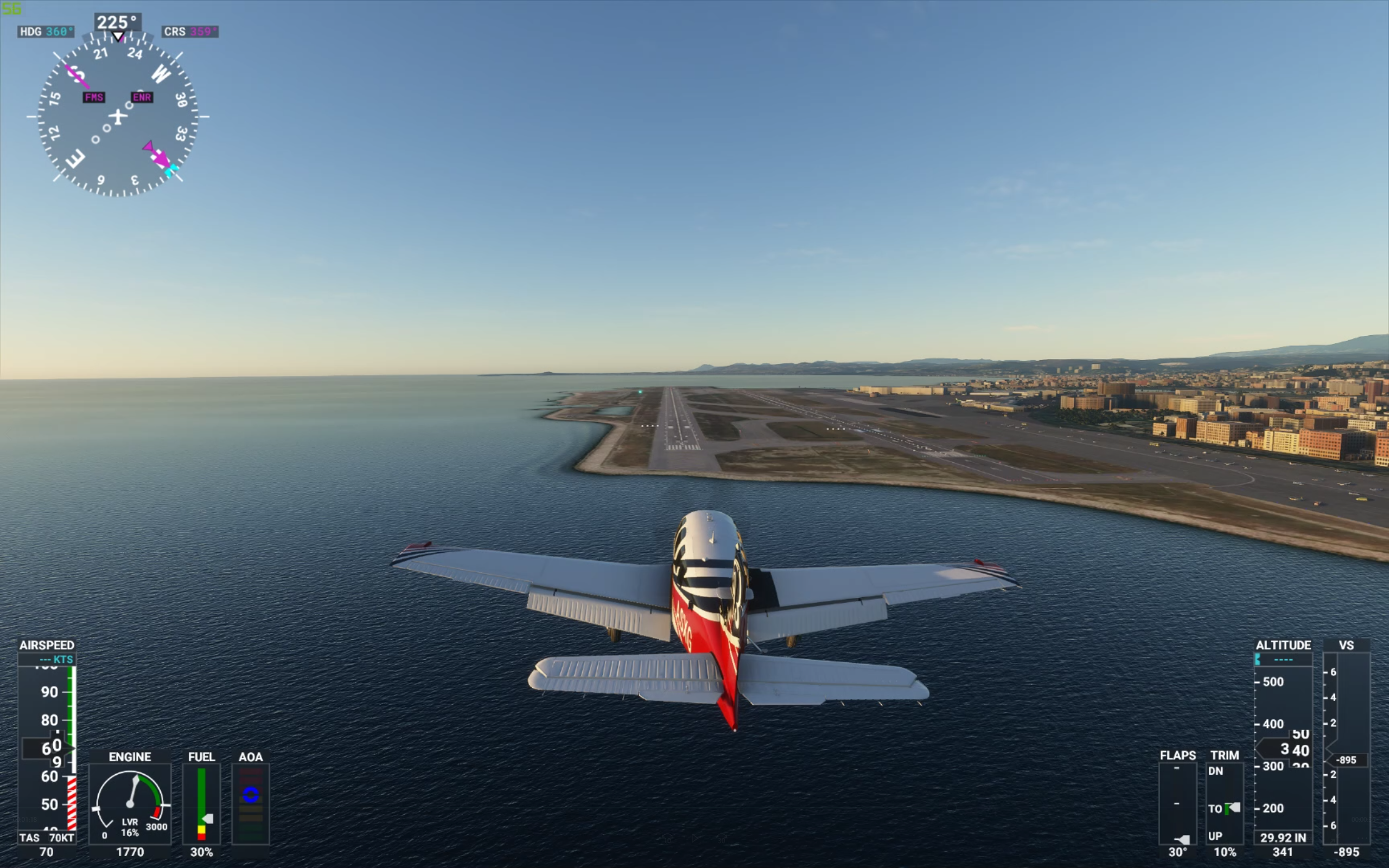
What is it? A flight sim with all the world to enjoy.
Expect to pay $60/£60
Developer Asobo Studio
Publisher Xbox Game Studios
Reviewed on: i7 9700K, RTX 2080 TI, 16GB RAM
Multiplayer? Up to 50 players
Link Official site
Do you ever wonder how it’d feel to take a few years away from games, and then peek back through the curtain once you’d become out of touch? Quite often, Microsoft Flight Simulator feels like that peek. In its scope and fidelity, it seems to be visiting from the future, when it’s commonplace to have access to a photorealistic Planet Earth and the freedom to explore it. When you can hop in a plane and fly over your own town, in the same weather conditions and lighting you can see outside your window. When ‘open world’ means just that.
What a dramatic way for the Microsoft Flight Simulator series to reappear after years under Dovetail’s DLC-focussed stewardship, and what a towering achievement from Asobo Studio. We’ll be talking about the impossible detail of its 1:1 world map for years to come; reading retrospectives about how this piece of software changed environmental design; wandering around other games that harness petabytes of real map data and Cloud AI grunt as a matter of course.
This is a seismic moment for PC gaming then. But what’s abundantly clear is that this is very much the beginning of Microsoft Flight Simulator’s journey, one moment on a roadmap that includes regular content updates on a monthly cadence and should by necessity also include just as many to fix some considerable teething technical issues. Release day has arrived, but whether that represents the launch of a finished product or an arbitrary demarcation along its journey to full completion is up for debate.

A total of 20 planes are included with the standard edition at launch, comprising three airliners, two jets and fifteen props. Using any one of those planes, you can position yourself on the runway of any airstrip in the world, take to the skies, and see a startlingly accurate recreation of the region below. It’s a terrible, terrible moment for anyone who invested in all those scenery addon packs for FSX.
It’s a premise with an appeal way beyond the flight sim’s usual remit. Who wouldn’t want to fly around in a playable, 4K, lightmapped version of Bing Maps with volumetric clouds and incredible weather effects? Who could resist the urge to try and find their own house? (I’ve still yet to successfully locate mine, but the search continues.) That speaks to a much wider crowd than the previous thirty-odd years of the series ever could.
With only a whisper of structure to your experience on the game’s part, you’re tacitly invited to devise your own adventures. Career progression only exists insofar as completing the flight school and ticking off the landing challenges and bush flights, which for their part offer excellent slices of curated content with leaderboard elements that give them chocolate digestive-like addictive properties. But you’re not going to spend 100 hours on them.

Instead, you’re going to plot a dark tourism tour on the world map, ticking off Chernobyl, The Polygon at Semipalatinsk, the Dylatov Pass. You’ll tick off every F1 circuit on the race calendar. And you’re going to have a fantastic time. The prospect of an entire planet to explore can be crippling too though, of course, so it would be great to see more curated experiences from Asobo in future.
The simulation model is more detailed than it’s ever been, a statement you can put to the test yourself by switching between ‘modern’ and ‘legacy’ models in the game settings.
So it’s a simulator for people interested in flight, and a magical virtual tourism portal for people interested at peering into the Mir Mine in a prop they’re controlling with a pad. The dividing line, then, is the method of control.
Traditionally, the simulation community reacts like the locals in that pub from American Werewolf in London to an influx of casuals—and I say that as someone with half a pretend cockpit sitting on my desk—but there’s no trace of sacrificing depth to cater for a broader audience here. The simulation model is more detailed than it’s ever been, a statement you can put to the test yourself by switching between ‘modern’ and ‘legacy’ models in the game settings. Its realism is scalable, too, to allow for zero-stress virtual tourism with an Xbox controller or all-out simulation with a HOTAS or yoke setup.

Frankly the Xbox pad pilots are well-served here considering the volume of functions necessary to pilot a plane. Rudder and trim adjustment are over-sensitive by default, but that’s an easy fix in the options menus. It seems absurd to be able to marshall such a rigorous physics model through the air using a pad, but it not only works, it feels great.
Setting up a HOTAS and a few cockpit panels proves more of a challenge, however. By default the game double-mapped certain functions to my Logitech X56, most annoyingly the throttle power. It’s an easy enough fix in the menus, but it took me a few attempted takeoffs to figure out which controls were cancelling each other out. With everything calibrated and the plane up in the air though, it’s pretty magical using a HOTAS.
Its approach to teaching you how to fly a plane isn’t that of a teacher, but a classroom. There’s everything in here you could possibly need if you wanted to learn how to set a flight plan with ATC, power up an airliner from scratch, set a VOR vector up to cruise altitude and then an ILS approach in order to land again at your destination. It just doesn’t tell you about any of it.

OK, that’s uncharitable. The flight school teaches you the very basics in a hardy little Cessna 152 over eight lessons, from taxiing onto the runway and taking off, to a spot of VOR navigation and landing. But for newcomers there are vast unknown unknowns that you wouldn’t think to search YouTube tutorials for because you don’t know they exist, or even why you’d need to use them in the first place. ATC is left almost entirely untouched by the tutorial, and navigation isn’t explained in enough detail to move straight on from flight school to a custom flight plan without considerable head-scratching and alt-tabbing. For all the game tells you, the pilot who flew your last long-haul flight sat at the yoke for hours on end making tiny adjustments every step of the way. This isn’t going to be a problem for long, but it’ll be the community’s content creators that solve it rather than the game itself.
If the complexity of its simulation presents a bit of a barrier for entry, though, Microsoft Flight Simulator’s technical issues lay barbed wire around the door.
However lost you might feel in the captain’s seat, staring at a mass of blinking warning lights, you always want to figure it out. There’s such intrinsic satisfaction in piecing together the puzzle of operating an aircraft, and every time you run through a pre-flight checklist you get your head around the cockpit layout that bit more. After a few hours you’re raising the crash level and setting the source to BATT without even thinking about it.
If the complexity of its simulation presents a bit of a barrier for entry, though, Microsoft Flight Simulator’s technical issues lay barbed wire around the door. First to contend with is the installation, which downloads a 500MB client in which the full 90GB install happens. Once it’s installed, it takes about three minutes from hitting ‘play’ to reaching the main menu on an i7 9700K, 16GB RAM and RTX 2080 TI and the game installed to SSD, and the same system can get about 25fps out of big cities and major airports at ultra settings in 1600p.

In reality that preset’s a bit of future-proofing. But while the visual quality is certainly scalable, performance doesn’t scale proportionally. That means landing at JFK is still a stuttery affair using any preset, including low, which generally produces 30-35fps in cities on my system and a much more consistent 60 out in the wilderness. Crashes are fairly commonplace on my system too—unplugging or connecting a device results in an instant CTD, and scenes causing low frame rates have also seemed to trigger them, albeit less frequently. At the time of writing, several days after release, an Nvidia game-ready driver has improved FPS performance, albeit slightly. Frame rate dips are generally an annoyance, but here they’re a real hindrance to your ability to control the plane. Landings require responsiveness and feather-light inputs, and if you’re seeing them in flip book-o-vision you’re not able to perform them properly.
However frustrating its performance issues are, there’s a voice inside your head saying ‘Can you just give it a minute to render the entire world? Would that be ok?’ Still, the fact is low frame rates impact your ability to fly the planes, and on the vast majority of systems, simply whacking the settings down to the low preset won’t produce stable 60fps. In other news: the PC gaming community has found its new Crysis.
In the shadow of Microsoft Flight Simulator’s incredible achievements, its annoyances, though notable, are forgivable. Poor frame rates aren’t reason enough to pass up on the chance to explore the planet in a manner games haven’t allowed you to before, and the slow-burn of mastering its planes is a real payoff. Just don’t expect perfection from day one.
Read our review policy
An incredible exploration portal with even greater potential once its tech issues have been addressed.



